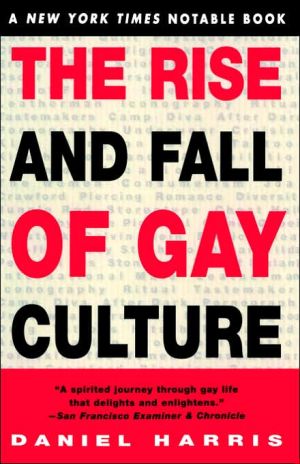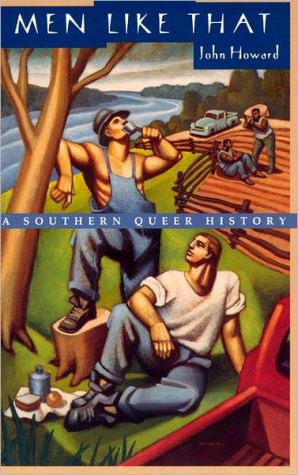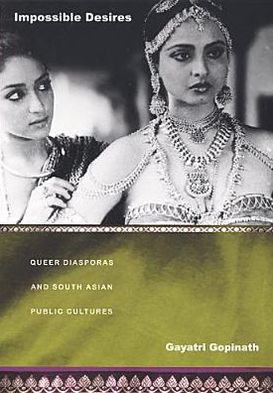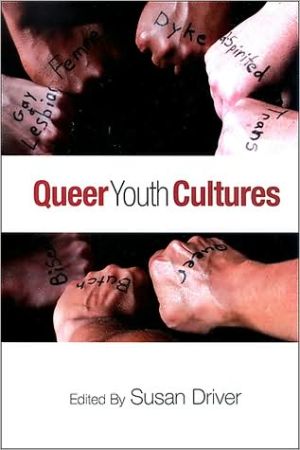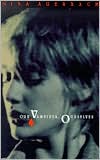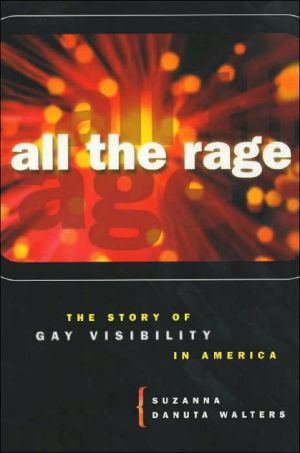The Rise and Fall of Gay Culture
In The Rise and Fall of Gay Culture, price-winning essayist and critic Daniel Harris traces the historical development and meaning of the artifacts and rituals of gay culture as they evolve over time. What is the source of the gay man's deification of such cult figures as Judy Garland and Joan Crawford? Why did black leather become such a mainstay of gay fashion? What role did gay men play in the eroticization of men's underwear during the past decade? What is the real significance of the...
Search in google:
In The Rise and Fall of Gay Culture, price-winning essayist and critic Daniel Harris traces the historical development and meaning of the artifacts and rituals of gay culture as they evolve over time. What is the source of the gay man's deification of such cult figures as Judy Garland and Joan Crawford? Why did black leather become such a mainstay of gay fashion? What role did gay men play in the eroticization of men's underwear during the past decade? What is the real significance of the AIDS quilt? As Harris explores these phenomena, he also looks at how the process of assimilation has transformed them from what were once vehicles for political protest into sanitized commodities. Pornography has abandoned its celebration of sensuality and been transformed into a sterile anatomical display of the body parts of untouchable superstars; S&M fetishists have lost their subversive appeal as dangerous sexual outlaws living on the fringes of civilized society and become "leatherfolk," starry-eyed soul-searchers who use the rituals of the dungeon for purposes of "self-discovery"; and diva worship has evolved into diva vilification, a campaign of defilement that relishes every humiliation visited upon its fallen goddesses. Can gay culture retain a separate and distinct identity as its major institutions lose their vitality and become both comfortable and familiar? Are homosexuals simply indulging in nostalgia when they attempt to resist assimilation and protect their ethnic heritage from cooptation at the very moment when their identity is collapsing? The Rise and Fall of Gay Culture raises crucial questions, not only about the decline of the homosexual sensibility but about the death of racial and cultural diversity in society at large. Village Voice Literary Supplement Harris's book is quietly but determinedly brilliant--not to mention long overdue....A witty, fiercely argued, often frightening, and entirely viable work of cultural criticism. -- Village Voice Literary Supplement
\ \ Chapter One\ \ \ The Death of Camp:\ Gay Men and Hollywood\ Diva Worship, from\ Reverence to Ridicule\ "If all the time the manager of the theater holds back the good roles from us, may we not insist upon understudying the stars?"\ Isak Dinesen,\ "The Deluge at Norderney"\ SOMETIME IN MY VERY early adolescence, I acquired, while living in the very heart of Appalachia, a land of lazy southern drawls, a British accent. No one around me had a British accent; my father was from Chicago Heights, my mother from Braggadocio, Missouri, and my peers were budding good old boys whose fathers drove tractors and pickup trucks and spoke in an unmusical twang that I, a pompous fop in my teens, found distinctly undignified.\ Given the hearty, blue-collar community in which I grew up, the origin of my stilted style of delivery remained a complete mystery to me until, as an adult, I began to watch old movies again. Over and over in the voices of film stars as different as Joan Crawford in Mildred Pierce and Katharine Hepburn in Suddenly, Last Summer, I heard the echoes of my own voice, the patrician inflections of characters who conversed in a manufactured Hollywood idiom meant to suggest refinement and good breeding, the lilting tones of Grace Kelly in Rear Window, Bette Davis in Mr. Skeffington, Tallulah Bankhead in Lifeboat, or even Glinda the Good Witch in The Wizard of Oz.\ In that tour de force of bitchy camp, The Women, the all-female cast speaks in two distinct accents: the harsh American cockney of the kitchen help, who squabble about the muddled affairs of their wealthy mistresses, and the high-society,charm-school intonations of the Park Avenue matrons who rip each other to shreds in the gracious accents of an Anglophilic argot concocted by the elocutionists at the major studios. Only Joan Crawford, the inimitable Crystal Allen, a social-climbing shopgirl who claws her way up to the top, can speak in both accents as the occasion requires, one for when she is at her most deceitful, hiding her common upbringing beneath the Queen's English of the New York aristocracy, and the other for when she is being her true self, a crass, money-grubbing tart who gossips viciously with her equally low-class cohorts at the perfume counter.\ To an insecure gay teenager stranded in the uncivilized hinterlands of North Carolina, the gracious ladies of Park Avenue and Sutton Place embodied a way of life more glamorous and less provincial than his own. The influence of Hollywood films was so pervasive among young homosexuals that it insinuated itself into our voices, weakening the grip of our regional accents, which were gradually overridden by the artificial language of this imaginary elite. Even today I have never succeeded in exorcising Joan, Bette, Grace, and Kate from my vocal cords, where they are still speaking, having left the indelible mark of Hollywood's spurious interpretation of classiness, culture, and gentility branded into my personality. This strange act of ventriloquism represents the highest form of diva worship and is the indirect outcome of my perception in my youth that, as a homosexual, I did not belong in the community in which I lived, that I was different, a castaway from somewhere else, somewhere better, more elegant, more refined, a little Lord Fauntleroy marooned in the wilderness. In my unconscious imitation of the voices of the great film stars, I was seeking to demonstrate my separateness, to show others how out of place I felt, and, moreover, to fight back against the hostility I sensed from homophobic rednecks by belittling their crudeness through unremitting displays of my own polish and sophistication. I was not attracted to Hollywood stars because of their femininity, nor did my admiration of them reflect any burning desire to be a woman, as the homosexual's fascination with actresses is usually explained, as if diva worship were simply a ridiculous side effect of gender conflicts. Instead, it was their world, not their femininity, that appealed to me, the irrepressibly madcap in-crowd of Antie Mame, of high spirits and unconventional "characters," of nudists and Freudians, symphony conductors and Broadway prima donnas, who lived in a protective enclave that promised immunity from shame and judgment, beckoning me with its broadmindedness and indulgence of sexual eccentricities.\ For me and countless other gay men growing up in small-town America, film provided a vehicle for expressing alienation from our surroundings and linking up with the utopic homosexual community of our dreams, a sophisticated "artistic" demimonde inhabited by Norma Desmonds and Holly Golightlys. Homosexuals' involvement with Hollywood movies was not only more intense but fundamentally different from that of the rest of the American public. For us, film served a deeply psychological and political function. At the very heart of gay diva worship is not the diva herself but the almost universal homosexual experience of ostracism and insecurity, which ultimately led to what might be called the aestheticism of maladjustment, the gay man's exploitation of cinematic visions of Hollywood grandeur to elevate himself above his antagonistic surroundings and simultaneously express membership in a secret society of upper-class aesthetes.\ Richard Friedel's novel The Movie Lover (1981) provides a telling illustration of how gay men used cinema for the defensive purposes of dramatizing their alienation. Burton Raider, its gay protagonist, is such a precocious coxcomb that he reads Vogue in his crib and refuses to wear the insipid teddy-bear bibs and Day-Glo overalls his parents buy for him, spurning sweaters with choo-choo-train prints and opting instead for kimonos and capes. In this affectionate caricature of the gay sensibility, Burton searches for some way to underscore his difference from his untidy, proletarian cousins, who despise him for his effeminacy and are content to catch frogs and throw stones at tin cans while he sobs on the sofa over Rita Hayworth movies or swoons over "the vertiginous Ann Miller and the noble Norma Shearer." One Christmas, he even asks a bewildered Santa Claus to bring him a lavish photo album of MGM stars, a present ideally suited for a young homosexual who "never quite belonged, never quite fit in" with the other children on his block.\ It is this feeling of estrangement that leads him to flaunt, through the imitation of film, what he modestly refers to as his "singularity." When both he and his cousins unwrap dump trucks, he imperiously sends Santa scurrying back to the North Pole to retrieve the forgotten book, sputtering at the bewildered saint's retreating figure, dashing for his sled, "what [am] I supposed to do now ... go over and play blue-collar worker" with his cousins, whom he watches contemptuously as they excavate a construction site by the Christmas tree. As my own voice and Burton's affectations reveal, the preciousness of the aesthete, our love of Japanese screens, Persian carpets, kimonos, capes, MGM stars, and British accents, reflects less the homosexual's innate affinity for lovely things, for beauty and sensuality, than his profound social discontent, which we attempt to overcome by creating flattering images of ourselves as connoisseurs and epicureans.\ The hard-bitten personalities of such Machiavellian careerists as Joan Crawford and Marlene Dietrich were, of course, not irrelevant to gay men's fascination with them. In fact, we related so intensely to the steeliness of characters like the murderous Bette Davis in The Little Foxes, who, with chilling equanimity, stands by as her choking husband writhes in convulsions before her, clutching his heart and helplessly groping for his missing blood pressure medication, that we used them as substitutes for ourselves, refashioning them in our own images. In the homosexual's imagination, Hollywood divas were transformed into gay men, undergoing a strange sort of sex change operation from which they emerged as drag queens, as men in women's clothing, honorary butch homosexuals as fearless as Joan Crawford in Johnny Guitar playing Vienna, a hard-boiled saloon keeper who guns down her rival, Mercedes McCambridge, or as Tallulah Bankhead in Lifeboat playing a shipwrecked reporter, adrift in the Atlantic, who uses her diamond Cartier bracelet as bait to catch fish. Drag queen imagery has, in fact, always pervaded gay men's discussion of the legendary Hollywood actresses, of Gloria Swanson, whose "acting has more than a whiff of the drag queen about it"; of Vivien Leigh, whom gay author Paul Roen identifies with "for the simple reason that I know she's really not a woman"; or of Mae West, who was "Mt. Rushmore in drag," as well as "the first woman to function as a leading man." (For decades, the latter was even suspected of literally being a biological male until her post-mortem finally convinced her skeptical gay fans that her curvaceous hips and imposing bosom were the real thing and not prosthetic foam rubber devices.)\ Because of our fiercely fetishistic involvement with diva worship, the star even in a sense traded places with her gay audience, who used her as a naked projection of their frustrated romantic desires, of their inability to express their sexual impulses openly in a homophobic society, and to seduce and manipulate the elusive heterosexual men for whom many homosexuals once nursed bitterly unrequited passions. In the process of this transference, the diva was voided of both her gender and her femininity and became the homosexual's proxy, a transvestite figure, a vampish surrogate through whom gay men lived out unattainable longings to ensnare such dashing heartthrobs as Clark Gable, Humphrey Bogart, and Gene Kelly.\ Although at first sight gay diva worship seems to have been as giddy as an adolescent girl's moonstruck infatuation with her teen idols, the homosexual's love of Hollywood was not an expression of flamboyant effeminacy but, rather, in a very literal sense, of swaggering machismo. For all of the lush sensuality of Greta Garbo melting limply into the arms of John Barrymore in Grand Hotel or Elizabeth Taylor batting her eyes at the impotent Paul Newman in Cat on a Hot Tin Roof, diva worship provided effeminate men with a paradoxical way of getting in touch with their masculinity, much as football provides a vicarious way for sedentary straight men to get in touch with their masculinity. Despite appearances to the contrary, diva worship is in every respect as unfeminine as football. It is a bone-crushing spectator sport in which one watches the triumph of feminine wiles over masculine wills, of a voluptuous and presumably helpless damsel in distress single-handedly mowing down a lineup of hulking quarterbacks who fall dead at her feet, as in Double Indemnity, where Barbara Stanwyck plays a scheming femme fatale who brutally murders her husband and then assists in dumping his lifeless body from a moving train in order to collect his insurance policy, or in Dead Ringer, where Bette Davis watches calmly as her dog lunges for the throat of her gigolo boyfriend. As one gay writer wrote about his attraction to the classic cinematic vamp, "as any drag queen can tell you: beneath all those layers of cosmetic beauty lies the kind of true grit John Wayne never knew." Before Stonewall, homosexuals exploited these coldblooded, manipulative figures as a therapeutic corrective of their own highly compromised masculinity. To counteract their own sense of powerlessness as a vilified minority, they modeled themselves on the appealing image of this thick-skinned androgyne-cum-drag-queen, a distinctly militaristic figure who, with a suggestive leer and a deflating wisecrack, triumphed over the daily indignities of being gay. Even today, gay men still allude to the star's usefulness in enabling them to "cope," in offering them a tough-as-nails persona that they can assume like a mask during emotionally trying experiences in which they imagine themselves to be Joan Crawford in Mildred Pierce building her restaurant empire or Bette Davis in Dark Victory nobly ascending the stairs to die alone in her bedroom, struck down in the prime of her life by a mysterious brain tumor. In an article on Ruby Rims, a female impersonator so immersed in celebrity culture that he has even named his cats "Eve" and "Channing," the New York Native describes how homosexuals fight back through imitation, through the often unconscious reenactment of Hollywood scenarios in the course of real-life experiences:\ [Rims] finds that if he is angered or frustrated by something or someone, he can usually give vent to his feelings by becoming Bette Davis.... "She's a release for me," he said, his face brightening. "I can walk right up to someone and say—gasp" 'You're an asshole,' and blow cigarette smoke in their face."\ Quite by accident, by pure serendipity, the diva provided the psychological models for gay militancy and helped radicalize the subculture. The homosexual's inveterate habit of projecting himself into the invincible personas of Scarlett O'Hara in Gone with the Wind or Alexandra del Lago in The Sweet Bird of Youth prepared the ground psychologically for the political resistance that was to come in the 1960s and 1970s when the gay man's internal diva was at last released from the subjective prison of his fantasy world to take the streets by storm. When drag queens fought back at Stonewall, chances are that what they had on their minds was the shameless chutzpah of their film icons, whose bravura displays of gutsiness they were reenacting. We consumed, assimilated, and recycled Hollywood images in such vast quantities and with such intense passion that it is interesting to speculate whether gay liberation would have been delayed had gay men not found inspiration in these militant paradigms. Something as retrograde and conformist as popular culture, with its uncritical advocacy of materialism, success, and blissfully domestic heterosexual relationships, was actually used for radical purposes, enabling a despised subculture to defend itself from the very America Hollywood celebrated. In the absence of the gay-positive propaganda in which contemporary gay culture is saturated, film became a form of "found" propaganda that the homosexual ransacked for inspiring messages, reconstituting the refuse of popular culture into an energizing force.\ As Rims's comments reveal, one aspect in particular of the Hollywood actress's persona appealed to gay men: her bitchiness, her limitless satiric powers, as in The Women where the characters taunt each other with such venomous comments as "where I spit no grass grows," "your skin makes the Rocky Mountains look like chiffon velvet," and "chin up—that's right, both of them," or in All About Eve in which Bette Davis toasts the slanderous critic who raises his wine glass to her across a restaurant by taking a ferocious bite out of a stalk of celery.\ Homosexuals were drawn to the image of the bitch in part because of her wicked tongue, her ability to achieve through conversation, through her verbal acuity, her snappy comebacks, the control over others that gay men were often unable to achieve in their own lives. The fantasy of the vicious, back-stabbing vagina dentata, always quick on her feet, always ready to demolish her opponent with a stunning rejoinder, is the fantasy of a powerless minority that asserts itself through language, not physical violence. Straight men express aggression through fistfights and sports; gay men through quick-witted repartee and caustic remarks. Straight men punch; gay men quip. Straight men are barroom brawlers; gay men, bitches. By providing the models for the beautiful shrew who, in film after film, attained a kind of conversational omnipotence, Hollywood fueled the homosexual's love of archness, of withering irony, which became the deadliest weapon of all in the arsenal of the pre-Stonewall homosexual. If shit-kicking amazons in sequins, ermine; and lame inadvertently helped each gay man nurture, like his own inner child, his own inner diva, and thus strengthened his will to resist his degradation at the hands of a homophobic society, wittiness was the primary element of his revenge, the method by which he gained the upper hand over his enemies, remaining in possession of the battlefield long after the victims of the winged barbs he hurled had beat a hasty retreat. Given the centrality to the subculture of the image of the arch queen, it is not an exaggeration to say that gay politics grew out of gay wittiness, whose acerbic muse was the mordant Hollywood goddess. Wittiness was the first very tentative step toward gay liberation, a vitriolic expression of discontent, of our disdain for American prudery, which we reviled through verbal protest, a compulsion to denigrate, to engage in cutthroat bickering, which eventually reached critical mass and led to concrete political action. Bitching, in other words, was a form of protopolitics. It channeled the bitter frustrations of homosexuals' lives into a pronounced conversational mannerism that marked an important symbolic stage in the gay man's effort to translate his otherwise impotent rage into practical measures for social reform.\ Hollywood suffused the gay sensibility during the first half of the twentieth century, not only because of its usefulness as "found" propaganda, but also because of the power of the new medium to build group solidarity. Given that homosexuals are an invisible minority whose members are not united by obvious physical characteristics and who are indeed often unrecognizable even to each other, they had to invent some method of identifying themselves as a group or risk remaining in the politically crippling state of fragmentation that for decades kept them from organizing to protect their basic civil rights. Blacks are united by their skin color, Chicanos by their language and place of origin, and the disabled by their infirmities. Homosexuals, however, are bound together by something less tangible: by their tastes, their sensibility, by the books they read, the clothes they wear, and the movies they watch.\ Before the gay sensibility developed, homosexuals constituted an alienated diaspora of scattered individuals who lived a splintered existence in localized pockets where they strove to efface every identifying mark that might compromise them in the eyes of outsiders, breaking their cover and thus leading to their professional downfall and personal humiliation. For a minority trying so vigorously to erase itself, political unity was a contradiction in terms. With the codification of the gay sensibility and the liberation of men trapped in the solipsistic isolation of intense shame, the homosexual suddenly recognized that he belonged to a group, an elaborate network of fellow solipsists who began to establish connections with each other. Bridges were built partly through the cultivation of shared tastes in popular culture, through a reverence for a group of cinematic heroes whose glamor lent an unprecedented centrality to the previously disjointed and atomized nature of gay life. Hollywood divas were drafted, naturally without their knowledge, into the role of quasi-gay-liberation leaders, their charismatic presence unifying a body of followers who flocked together, not necessarily because of their idol's peculiar talents as an actress, but simply because she provided a kind of magnet. Large numbers of gay men established around these stars a new type of esprit de corps as the votaries of a particular pantheon of goddesses. Fandom, in other words, was an emphatic political assertion of ethnic camaraderie, as was the gay sensibility itself, which did not emanate from some sort of deeply embedded homosexual "soul," but arouse as a way of achieving a collective subcultural identity.\ Up until the 1960s, the performer served as a bellwether, a prophet without a religion, a platform, a cause, a messiah whose disciples were more in love with themselves than they were with their star. The priority of audience over artist becomes particularly clear in the case of the ultimate idol of the gay masses, Judy Garland. Her concerts during the 1950s and 1960s were so popular among homosexuals that, in each city in which she appeared, local gay bars emptied as their patrons came out en masse to hear a dazed and disoriented performer, slumped over the microphone, croak out the broken lyrics of songs that, in her final days, she had difficulty remembering.\ Garland's force as a lodestone, an excuse for a public gathering of homosexuals, emerges in the existing accounts of her concerts, which witnesses describe as orgiastic rites of blind idolatry during which screaming multitudes of homosexuals, whipped up into a frenzy by such plaintive songs as "Over the Rainbow" and "The Man That Got Away," wept out loud, laying on the stage at their divinity's feet mountains of flowers. "It was as if the fact that we had gathered to see Garland gave us permission to be gay in public for once," one older gay man wrote of a 1960 concert, while another recalled a performance he attended as "more a love-in than a concert":\ When Judy came onto the stage, we were the loudest and most exuberant part of that audience. We not only listened, we felt all the lyrics of all the songs. Judy Garland was all ours; she belonged to every gay guy and girl in the theatre. I like to think that we were the greatest part of that audience; the part that Judy liked best."\ Although Garland was in many ways a brilliant performer, homosexuals came to regard her simply as the catalyst for the raucous, gay pride "love-ins" that erupted spontaneously during her concerts. Her uncritical mass appeal helped overcome our fragmentation to create for only a few hours, within the safe confines of an auditorium, an ephemeral, transitory "community" that lured us out of the closets in order to experience the unforgettable thrill of a public celebration of homosexuality. Those commentators who insist on trying to explain gay diva worship exclusively on the basis of the intrinsic appeal of a particular star—as a result of her pathos, suffering, vulnerability, glamor, or sexiness, to give only a few of the reasons that have been offered—have in many ways chosen as their starting point a mistaken premise. The answer to the proverbial question "why did gay men like Judy Garland so much?" is that they liked, not her, so much as her audience, the hordes of other gay men who gathered in her name to hear her poignant renditions of old torch songs that reduced sniffling queens to floods of self-pitying tears. The hysterical ovations her audiences gave her were in some sense applause for themselves. Garland was simply the hostess, a performer who good-naturedly rented out her immense reputation as an occasion for a huge gay party, a dry run for Stonewall, a dress rehearsal for the birthday bash of the burgeoning gay rights movement, which her last and most important concert, her funeral, was to inspire only a few years later.\ It was this shared knowledge of popular music and film that created the very foundations of camp. Homosexuals quickly incorporated into their conversations and style of humor a body of subcultural allusions, ranging from Carmen Miranda in The Gang's All Here singing "The Lady in the Tutti-Frutti Hat" in eight-inch platform heels on a runway framed by giant strawberries, to Marlene Dietrich wearing a blond Afro crooning "Hot Voodoo" in Blonde Venus while chorus lines of cavorting Negresses wearing war paint do the cakewalk behind her, to Maria Montez in Cobra Woman, dancing a kootch dance in a slinky, sequined snake dress as she selects terrified subjects for blood sacrifices, who are borne off shrieking to their unhappy fate.\ Through constant quotation of the scripts of Hollywood movies in our private conversations, we created a collage of famous lines and quips, which, after frequent repetition, achieved the status of passwords to a privileged world of the initiated, who communicated through innuendo, through quoted dialogue pregnant with subtext. A miscellaneous body of canonic lines was lifted straight out of the masterpieces of popular culture and exploited as a way of declaring our membership in the forbidden ranks of a secret society:\ Toto, I don't think we're in Kansas anymore.\ But you are, Blanche, you are in that chair.\ I have always depended on the kindness of strangers.\ Buckle your seatbelts, it's going to be a bumpy night.\ What is the scene? Where am I?\ What a dump!\ Jungle red!\ When gay people engaged in camp before Stonewall, they often did so as a way of laughing at their appropriation of popular culture for a purpose it had never been intended to serve: that of identifying themselves to other homosexuals and triggering in their audience instantaneous recognition of stock expressions, gestures, and double entendres that strengthened the bonds that held them together. Even today, a performer as gifted as Lypsinka, whose acts consist entirely of an intricate series of quotations from films, succeeds as a brilliant comic by virtue of her uncanny ability to play on her audience's gleeful sense of unity as a minority, an ethnic group that relives, long after we have established other channels of communication, the power of allusion to increase solidarity. Lypsinka simply mouths the words "no wire hangers" or "Barbara, pleeeeeease! and her audience howls with laughter caused, not by the intrinsic hilariousness of the lines, but by the delight we take in the unanimity of our response, in our virtually reflexive recognition of the source of the allusions. This esoteric knowledge contributes to the elitist pleasure of a coterie sealed off from the rest of the uninitiated American public.\ Camp and diva worship also served a more narrowly personal function than just providing us with a repository of subcultural narratives that became our own private language. Before Stonewall, allusions to such films as The Women, Mildred Pierce, Now, Voyager, A Streetcar Named Desire, or Gilda were ingeniously incorporated into the extremely delicate business of cruising for friends and sex partners, many of whom would undoubtedly have been far too timid to state their preferences openly. How much simpler it was to encode one's sexual orientation into something as elusive and uncompromising as a taste for a particular actress, whose name could be dropped casually in the course of a conversation in hopes that one's partner would pick up the gambit and agree that he did indeed like Judy Garland, that Mae West was outrageously funny, and that Tallulah Bankhead was, as she herself once said, "as pure as the driven slush." As exemplified by that time-honored expression "a friend of Dorothy," a particular taste in film provided a useful come-on for cautious gay men, who could reveal themselves to others without risking exposure, since only a fellow insider would recognize the allusion, thus allowing the homosexual to circumvent the potential embarrassment of a dismayed or even hostile reaction to a flat declaration. Over the decades gay men became so adept at communicating their forbidden desires through camp allusions that a sort of collective amnesia has descended over the whole process, and we have lost sight of the fact that our love for performers like Judy Garland was actually a learned behavior, part of our socialization as homosexuals. Many gay men still mistake their cultish admiration for the likes of Tippi Hedren, Kim Novak, or Barbara Stanwyck as an expression of an innate gay predisposition, as if the love of actresses was the result of a physiological imbalance in our smaller hypothalamuses, of a diva chromosome in our DNA which produced a camp sensibility that somehow preceded our awareness of our homosexuality.\ As early as the 1950s, our use of camp as a method of cruising began to change. Irony was always present in the subculture's involvement with celebrities, partly because of the homosexual's sly awareness that he was misusing something as naive and wholesome as popular culture, with its golly-gee-whiz, Kansas-bred Dorothys and its Norman Rockwell happy endings, to reinforce something as illicit and underground as his solidarity with other homosexuals. As time went on, however, the note of facetiousness implicit in many gay men's treatment of Hollywood became louder and louder, until the wry smile of camp became the cackling shriek of the man who could no longer take seriously the divas he once adored.\ By the early 1960s, some gay men had begun to express repulsion for our obsequious fawning over celebrities. Patrick Dennis's 1961 camp masterpiece Little Me provides a clear instance of the increasing skepticism homosexuals were bringing to their involvement with Hollywood. The novel purports to be the memoir of Belle Schlumptert, aka Belle Poitrine, a great film actress, but in fact this imaginary autobiography, complete with hilarious photographs documenting Belle's meteoric rise to fame from her humble beginnings as the daughter of a scarlet woman, is an irresistibly scathing satire of a megalomaniac piece of trailer trash who uses the casting couch as a trampoline to catapult herself into stardom. By the 1980s and 1990s, the pantheon of immortals, while still treated reverently by many gay men, had become fair game for ridicule, as when New York drag queens commemorated the 1981 release of Mommie Dearest by dressing up as Joan Crawford and kicking life-size effigies of her daughter Christina up and down Christopher Street. Similarly, in 1987, New York Native columnist Dee Sushi imagined a hypothetical Broadway musical based on Whatever Happened to Baby Jane? in which a chorus line of spinning wheelchairs would whirl across the stage like dervishes to the accompaniment of a song entitled "But Cha Are!"\ One of the reasons for the change from reverence to ridicule, from Joan Crawford as the bewitching siren to Joan Crawford as the ax-wielding, child-beating, lesbian drunk, is that, in the minds of younger homosexuals, the diva had come to be perceived as the emotional crutch of the pathetic old queen. Surrounded by his antiques and registered crockery, this geriatric spinster compensates for the loneliness of his thwarted life by projecting himself into the tantalizing hourglass figures and haute couture ball gowns of his favorite actresses. For gay men under the age of 40, the classic film star has become the symbolic icon of an oppressed early stage in gay culture in which homosexuals sat glued to their television sets feasting their eyes on reruns, achieving through their imaginations the sense of self-worth that gay men now attain by consuming the propaganda our political leaders disseminate in such vast quantities. For the contemporary homosexual, who prides himself on his emotional maturity and healthiness, the use of the diva to achieve romantic fulfillment through displacement is the politically repugnant fantasy of the self-loathing pansy whose dependence on the escapism of cinema must be ritually purged from his system. We accomplish this catharsis by creating through conversations, theater, and even cabaret acts images of the vulgarity and psychological desperation of glamorous actresses, of Joan Crawford clobbering Christina with a can of bathroom cleanser or chopping off the head of her faithless husband in Strait-Jacket.\ John Weir's novel about AIDS, The Irreversible Decline of Eddie Socket (1989), revolves around this act of purgation. Like Rims, its dying protagonist attempts to face his bleak future by staging what he calls "Barbara Stanwyck moment[s]." With his inspired sense of melodrama, he appears to be a typical example of a gay man with a relentlessly active internal diva, but, far from offering "empowerment," she becomes a vampire that feeds on his vitality, an incubus that saps his life of its reality and makes him feel that "the whole fucking world was in quotes. Was death going to be in quotes, too?" Lying in his excrement in his hospital bed, abandoned by the nurses and orderlies who are too afraid to touch him, he wonders out loud to a friend:\ Who's the main character in my life? ... Who is starring in my life? It can't be me ... I'm just a walk-on.... Not even a supporting player. Not even a cameo appearance by a long-forgotten star. I'm just an extra. No one else is starring in my life. That's why they're halting production. It's a bad investment for the studio.\ Returning from the hospital, his friend has an hallucination that be interpreted as a diatribe against the gay escapist whose obsession with actresses diminishes the reality of his life, starving it of its meaning and providing a safe emotional haven from the difficulties of being a homosexual. As he sits on a crosstown bus, Elizabeth Taylor appears out of the blue and proceeds, before his very eyes, to pull herself apart like Lego blocks in order to disabuse him of his adoration, first removing her contact lenses, then her chin, cheeks, breasts, left buttock, and right kneecap, until he realizes that, despite all of her glamor, "she's a walking prosthesis," "a pile of rubber parts on the floor between us,... all diminished." Stuffing herself into a shopping bag, she hobbles off the bus, no longer the alluring emblem of the life the homosexual cannot live, but a Mr. Potato Head. This apocalyptic image of Taylor's self-destruction is pivotal to a book that is, in many ways, an anticamp requiem, an expression of the young homosexual's mounting impatience with the retrograde use of Hollywood as a security blanket.\ The sacrosanct image of the Hollywood deity was also tarnished by the fact that, in the late 1960s and 1970s, gay men began holding their proto-gay-liberation leaders to a higher political standard. Because of the role actresses played in bringing gay men together as fans and instilling in them a sense of national identity that transcended the fragmented world that existed before Stonewall, homosexuals were at first unswervingly loyal to their patron saints and remained largely blind to their glaring deficiencies as the subculture's unofficial envoys to mainstream society. As we became more politically aware, however, and more conscious of our clout as a unified minority, we became impatient with the patronizing maternalism of early gay politics, which had produced the great matriarchy of mother hens who hovered protectively over their broods of gay fans. After Stonewall, we were no longer satisfied with the crumbs of celebrities' halfhearted comfort and support, with the meager consolation they offered for the humiliation of our social ostracism, which rarely amounted to more than such statements as "you poor little darlings" or "leave them alone, you bullies, they're so harmless."
Introduction1The Death of Camp: Gay Men and Hollywood Diva Worship, from Reverence to Ridicule8The Evolution of the Personals and Gay Romance40The Invention of the Teflon Magazine: From After Dark to Out64A Psychohistory of the Homosexual Body86The Evolution of Gay Pornography: Film111The Evolution of Gay Pornography: Literature134The Origins of the Underwear Revolution in the Gay Subculture160The Death of Kink: Five Stages in the Metamorphosis of the Modern Dungeon179The Aesthetic of Drag203The Kitschification of AIDS219Glad-to-Be-Gay Propaganda239
\ Village Voice Literary SupplementHarris's book is quietly but determinedly brilliant--not to mention long overdue....A witty, fiercely argued, often frightening, and entirely viable work of cultural criticism. -- Village Voice Literary Supplement\ \ \ \ \ Publishers Weekly - Publisher's Weekly\ This book is filled with striking observations and it answers questions you've always been too apprehensive to ask Why are gays mad for Joan Crawford?. Freelance journalist Harris unhinges scores of commonly held tenets of the modern male homosexual faith while examining gay culture before Stonewall and what it has become since. He takes the book trade to task for feeding gay audiences "the literary equivalent of a warm glow," condemns modern drag for being ridiculous and berates the contemporary gay man for turning "the aestheticism of art and culture into the aestheticism of products." Gay culture and the "aestheticism of maladjustment" arose, Harris argues, from oppression; it is quickly falling, he concludes, as a result of consumerist assimilation. There is too much loose prose and thought for this book to be the groundbreaking treatise it might have been. So don't expect a treatise, but get your wry smiles ready for intentionally? hilarious discussions of Calvin Klein underpants as "a pivotal moment in the history of fashion" and the "death of kink." The well-turned phrases collected here in themselves make a book of aphorisms but are definitely not for the hopelessly heterosexual. May\ \ \ Library JournalDefining gay sensibility "strictly as a political response to oppression, and not as an innate characterological predisposition for the arts and aestheticism," Harris measures the effects of assimilation on the white, middle-class, male homosexual community. Characterizing the propaganda of gay liberation as a unique juxtaposition of political statements and psychological self-acceptance bromides, he posits that "the economic exploitation of homosexuals has involved a painfully protracted courtship," during which they have become victims of cultural erosion. Harris compares various aspects of the pre- and post-Stonewall subculture, ranging over topics such as underwear ads from Ah Men and International Male catalogs; pornographic literature and film; After Dark and Out magazines; the transformations of hypermasculine S/M leather culture and hyperfeminine drag; and, finally, "The Kitschification of AIDS." Harris's astute observations, though often undermined by overbroad generalizations and his own self-acknowledged ambivilence, make this provocative cultural criticism and fascinating reading.James Van Buskirk, San Francisco P.L.\ \ \ \ \ R. L. PelaThe death of gay culture isn't a new idea, but Harris provides fascinating details from the past that illuminate current gay trends, then he shows us how and why these trends cannot survive...\ Harris is cerain to offend some gay activists and other governors of PC with his assessment of several sacred queer cows...though its hard to imagine exactly what any forward-thinking homo could dispute here.\ — The Advocate\ \ \ \ \ \ Kirkus ReviewsA muddled polemic that sprays bile in many directions but hits few of its targets.\ Essayist Harris contends that there is a distinct gay subculture in America that is headed for extinction as a result of gay people's assimilation into the cultural mainstream. As evidence, he traces the evolution of selected subjects of traditional gay interest, such as personal ads, bodybuilding, pornography, sadomasochism, drag performances, and gay-positive literature. His oft-reiterated conclusion is that "the obliteration of the gay sensibility, of our effeminacy, campiness, promiscuity, and aestheticism, is actually built into the program of the gay movement, which . . . will ultimately strip us of our distinctive ethnic features" by "disseminating images of happy, healthy homosexuals" who have become "unthreatening replicas of mild-mannered heterosexuals." He faults the standard hero of recent pornographic literature for being "an ambiguous erotic half-breed," having "the libido of a gay man but the body and mannerisms of a truck driver," as if the notion of a gay truck driver can only speed the corrosion of the epicene gay sensibility. Harris often falls back on a primitive argument that blames advertisers for courting the gay market and thereby poisoning "subcultural" gay minds with mainstream propaganda. Even plain white underwear is a culprit, says Harris: "Many homosexuals . . . want their briefs dehomosexualized." When Harris posits that the run-of-the-mill '90s drag queen dresses like Sissy Spacek at the climax of Carrie, one can only wonder what clubs he frequents. A chapter called "The Kitschification of AIDS" sneers at maudlin AIDS tearjerking, but doesn't indicate why it's more reprehensible than with any other disease or disaster, or why publicity for more extreme non-mainstream values should have any place in AIDS fundraising.\ An irksome screed that's contemptuous of social progress and creepily nostalgic for the days of public repression and maniacal Judy Garland worship.\ \ \
